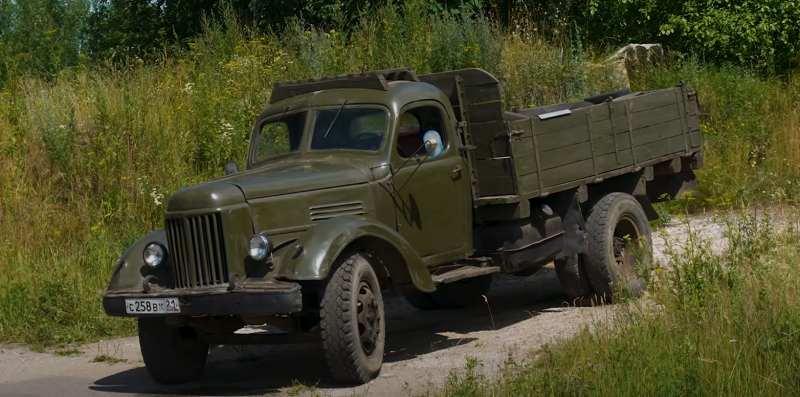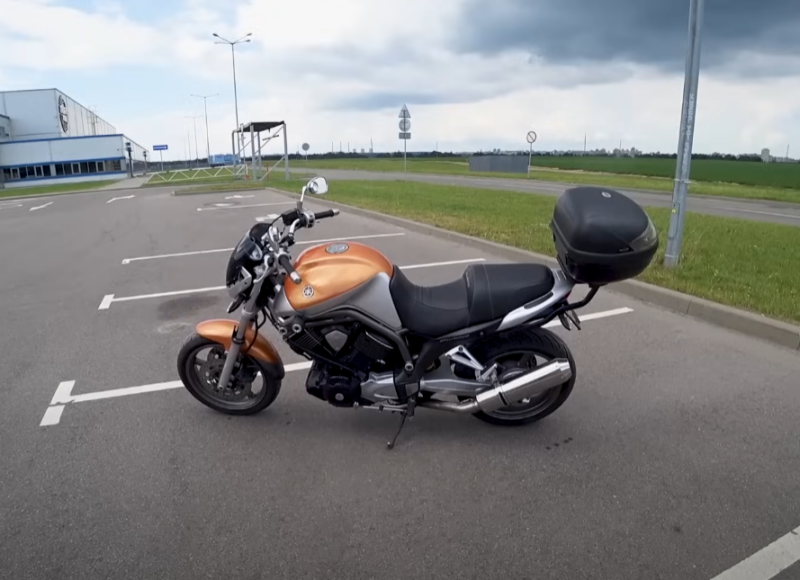One of the iconic Soviet trucks was the ZIL-164. These cars were produced in various versions from 1957 to 1964. Despite the rather short conveyor life, the drivers respected this model, otherwise they would not give her the nickname "Zakhar". Recall that this was the name of the famous "three-ton" of the war years - ZIS-5.
Differences from the ZIS-150
In fact, the ZIL-164 is a continuation of the second generation line of the Likhachev Plant, started with the ZIS-150. Therefore, the appearance of these two cars is similar. Moreover, now many people confuse these two models, although for a specialist one glance is enough to understand.
 In Russia, there are only a few such cars now. Photo: Youtube.com
In Russia, there are only a few such cars now. Photo: Youtube.comThe main external difference between the ZIL-164 and the ZIS-150, which immediately catches the eye, is the radiator grille. In the older model, it is semi-oval, with horizontal slots. It seems that the designers cared about aerodynamics, but in fact, trucks from the USA are to thank for the design.
ZIL-164 has a flat grille with vertical slots. It is by this feature that trucks can be distinguished from afar.
But in terms of technical characteristics, the ZIL-164 is significantly superior to its predecessor:
✅ Reinforced frame
✅ Modified 100 hp engine. With. - this is 5 liters. With. more than the ZIS-150
✅ New radiator
✅ Improved heater
✅ Hot air windshield blowing system appeared
There were many improvements on hodovke and bodywork. All problem areas have been addressed. There were amplifiers of spars, and sheets were added to the springs to increase the carrying capacity.
 Front suspension ZIL-164. Photo: Youtube.com
Front suspension ZIL-164. Photo: Youtube.comCompared to the ZIS-150, which was a typical military vehicle, the ZIL-164 has become a truck with a high level of comfort. Now it seems ridiculous, but the drivers were delighted with the new car. For example, the ZIL-164 cab was immediately made all-metal, and the seats were spring-loaded. The driver's seat even had height adjustment, which seemed fantastic for Soviet trucks.
TTX
ZIL-164 has a carrying capacity of 3,5 to 4,5 tons. It depends on the type of tires installed on the truck and on what road surface it had to move. On asphalt, you can carry 4-4,5 tons.
On unpaved and country roads, the maximum weight of the cargo is declared at around 3,5 tons. Of course, you can exceed it, but the car’s cross-country ability then fell sharply. During the thaw, overloads on dirt roads are undesirable. Although, if the drivers were driving several cars at once and were experienced, they often loaded 5 tons each.
The ZIL-164 engine, as it should be for a Soviet power unit, is carbureted. The working volume of the row "six" is 5,5 liters. Power - 100 liters. with., which is 5 "horses" more than the ZIS-150.
A 150-liter gas tank, a strainer is located on the filler neck, which traps large particles of dirt or debris. The motor is designed for fuel brand A-66.
 Rear suspension ZIL-164. Photo: Youtube.com
Rear suspension ZIL-164. Photo: Youtube.comThe engine is mounted on the frame using three supports and rubber pads. The carburetor on the ZIL-164 was improved compared to the ZIS-150 - this is the MKZ-K-82M. The last letter in the index just meant "modernized." This unit is fully interchangeable with the MKZ-K-82, so that it could be moved from one truck to another without any alterations or modifications.
Gearbox - five-speed. It is more advanced than the ZIS-150.
The steering, which is natural for the late 1950s, was without hydraulic booster. Therefore, drivers of old trucks have always been distinguished by strong hands. Of course, it’s not difficult to steer a car on the go, but maneuvering in narrow places is another problem. For those who want to understand how it was at least approximately, we can advise you to try to deploy any Soviet passenger car in the yard.
Upgrade 1961 of the Year
Interestingly, ZIL-164 was originally a temporary solution. In fact, this truck was a deeply modernized version of the ZIS-150. Work on a new generation car began in 1953 - meaning the future ZIL-130.
But since the upgraded model was needed "yesterday", I had to launch something earlier. So ZIL-164 got on the conveyor in 1957. It was at this time, by the way, that the first prototype of the 130 model appeared.
 Engine ZIL-164. Photo: Youtube.com
Engine ZIL-164. Photo: Youtube.comIn 1961, when it was already necessary to change the generation of trucks, the designers upgraded the ZIL-164. At the same time, they introduced a number of advanced technical solutions from the new model. The upgraded version received the letter "A" in the index.
ZIL-164A had a new single-plate clutch. The gearbox was also modified by changing the ratio of gear ratios. In order for the engine to interact with the new clutch, the flywheel had to be replaced. There was an improved fuel pump with more than twice the performance. He pumped 125 liters per hour against 60 for the pre-styling ZIL-164.
The upgraded truck was constantly being improved. The fact is that the launch of the new ZIL-130 model was postponed, and there were more and more components and assemblies for it. Therefore, they were introduced into the model that was on the conveyor.
Interestingly, the new nodes were completely interchangeable with the old ones. If desired, they can be changed and combined.
Modifications
ZIL-164 was produced in different versions. Before starting to list them, it should be noted that all modifications with the letter “A” after the numbers 164 in the title are restyling.
 ZIL-164 in Vietnam. Photo: Youtube.com
ZIL-164 in Vietnam. Photo: Youtube.comThe main truck was ZIL-164 (A). This is a standard onboard model with a wooden body and a 100 hp engine. With.
For permanent work with trailers, the ZIL-164R (AR) was produced. This modification had a forced up to 109 liters. With. engine and other carburetor.
For the military, modifications were produced with shielded electrical equipment. They were called ZIL-164D (AD).
Chassis was produced to install special equipment and non-standard cargo platforms. They were called ZIL-164G (AG). Such trucks were used both in the "civilian" and in the army.
Thanks to cooperation with the Mytishchi Machine-Building Plant, the ZIL-164 family was replenished with a number of specialized models. These are dump trucks, construction and agricultural. There were even truck tractors. They have the letter combination "MMZ" in the index.
Small batches produced gas versions of the truck, but they were called ZIL-166 (A). The motors could also run on gasoline. But such trucks were not widely used. There was too much gasoline in the country, so there was no point in saving it.
 This is the same "Kolyma" modification. Photo: Youtube.com
This is the same "Kolyma" modification. Photo: Youtube.comThe most interesting was the "Kolyma" modification of the ZIL-164 - it was distinguished by the presence of a second rear axle. This truck had nothing to do with the Likhachev Plant - it was remade at one of the local enterprises.
There were also export versions of the ZIL-164. According to the old Soviet tradition, they were assembled by the best craftsmen, and only the highest quality parts were used for these cars. The wiring was also carefully insulated. Interestingly, only forced engines were installed there, and the carrying capacity was 5,5 tons.
ZIL-164 was created as a temporary solution until the designers manage to launch the next generation model into the series. Despite this, the truck turned out to be reliable, modern and comfortable, for which Soviet drivers fell in love with it.










